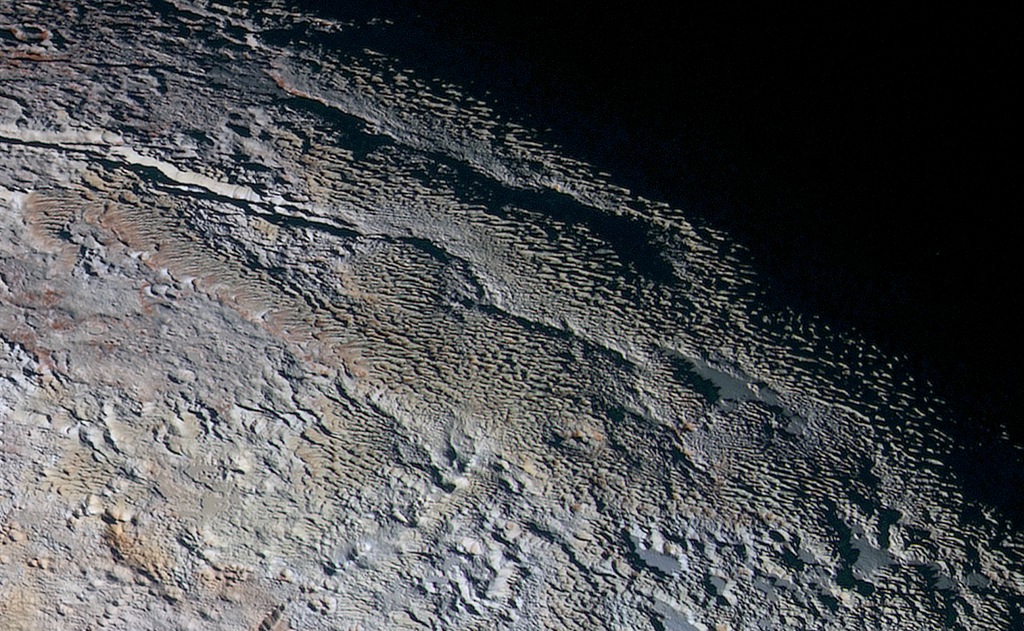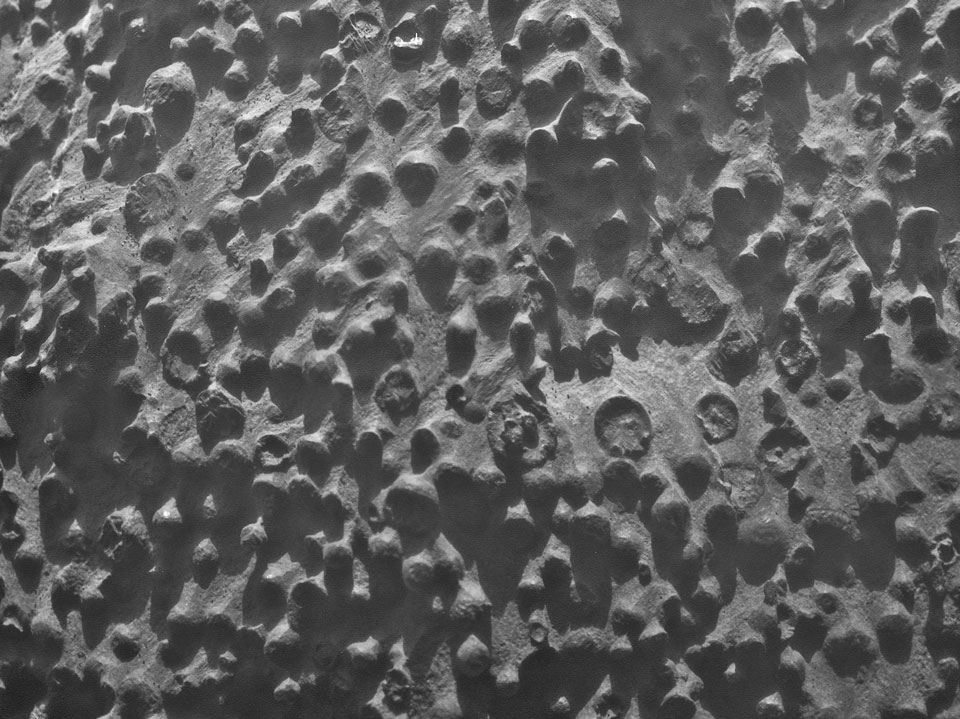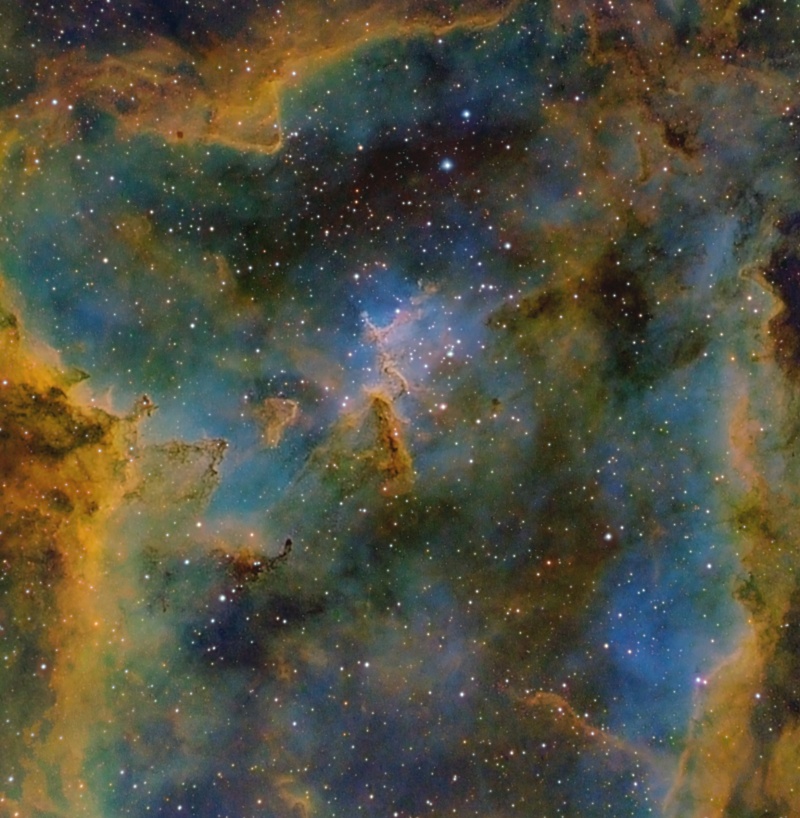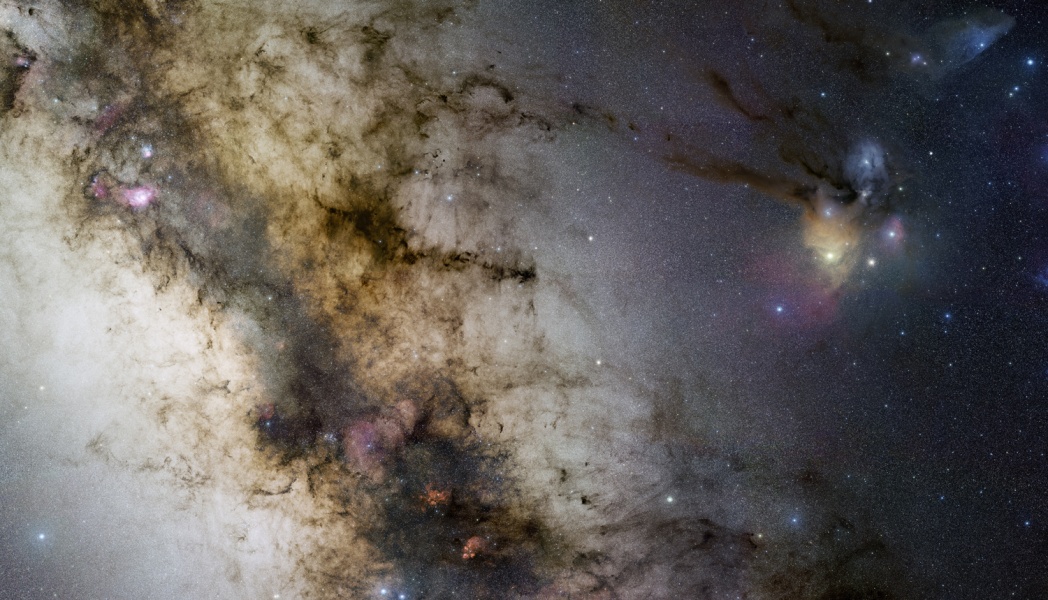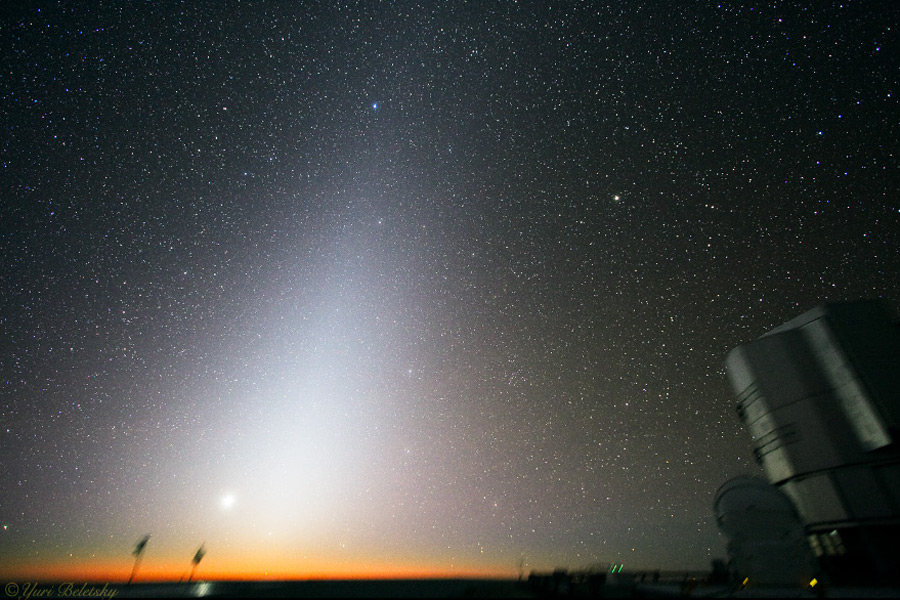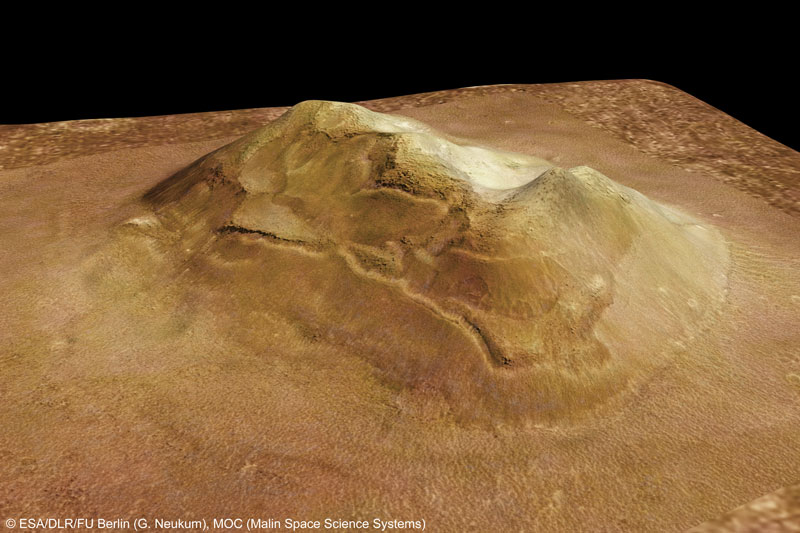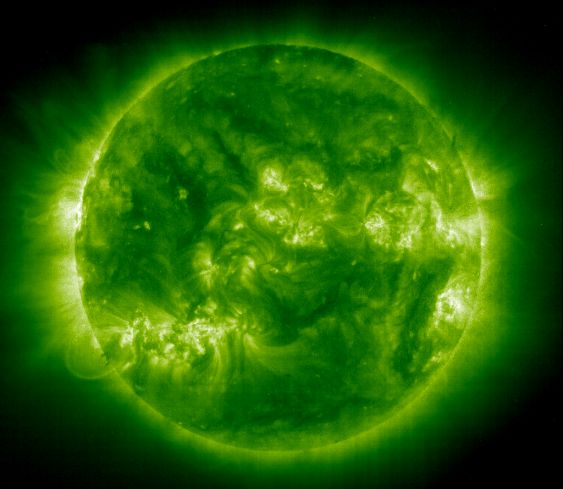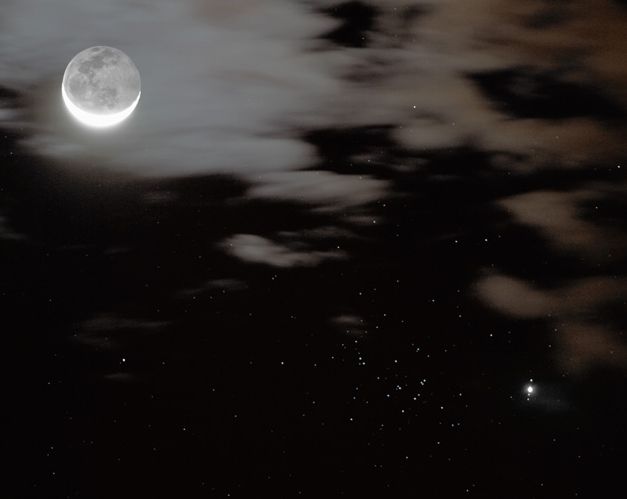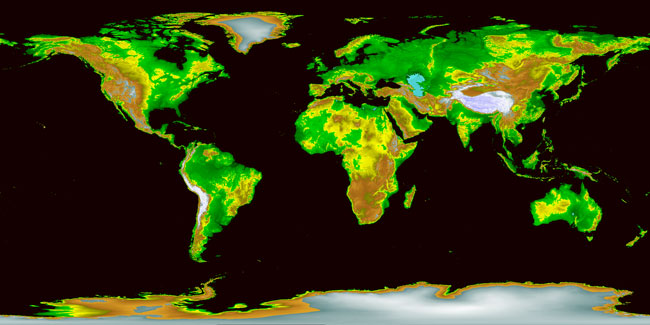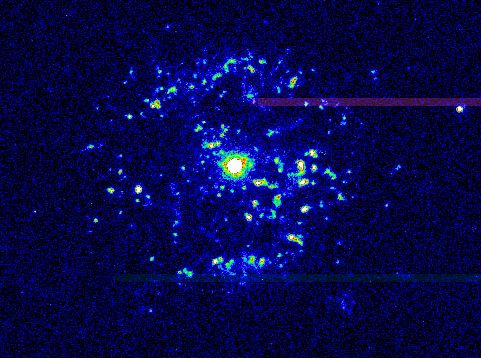| << Previous | Index | Next >> |
2015 A mountainous region informally known as Tartarus Dorsa sprawls some 530 kilometers (330 miles) across this Plutonian landscape. Recently downloaded from New Horizons, it combines blue, red, and infrared image data in an extended color view captured near the spacecraft's close approach to Pluto on July 14. Shadows near the terminator, the line between Pluto's dim day and night, emphasize a rough, scaly texture. The stunning image resolves details on the distant world about 1.3 kilometers (0.8 miles) across. Refering to a part of Hades in ancient Greek mythology, Tartarus Dorsa borders Tombaugh Regio to the east.
2014
2013 Here in the Milky Way galaxy we have astronomical front row seats as M81 and M82 face-off, a mere 12 million light-years away. Locked in a gravitational struggle for the past billion years or so, the two bright galaxies are captured in this deep telescopic snapshot, constructed from 25 hours of image data. Their most recent close encounter likely resulted in the enhanced spiral arms of M81 (left) and violent star forming regions in M82 so energetic the galaxy glows in X-rays. After repeated passes, in a few billion years only one galaxy will remain. From our perspective, this cosmic moment is seen through a foreground veil of the Milky Way's stars and clouds of dust. Faintly reflecting the foreground starlight, the pervasive dust clouds are relatively unexplored galactic cirrus, or integrated flux nebulae, only a few hundred light-years above the plane of the Milky Way.
2012 Why are these strange little spheres on Mars? The robotic rover Opportunity chanced across these unusually shaped beads earlier this month while exploring a place named Kirkwood near the rim of Mars' Endeavour Crater. The above image taken by Opportunity's Microscopic Imager shows that some ground near the rover is filled with these unusual spheres, each spanning only about 3 millimeters. At first glance, the sometimes-fractured balls appear similar to the small rocks dubbed blueberries seen by Opportunity eight years ago, but these spheres are densely compacted and have little iron content. Although it is thought that these orbs formed naturally, which natural processes formed them remain unknown. Opportunity, an older sibling to the recently deployed Curiosity rover, will continue to study these spheres with the hope that they will provide a new clue to the ancient history of the surface of the red planet.
2011 Tsunamis this large don't happen on Earth. During 2006, a large solar flare from an Earth-sized sunspot produced a tsunami-type shock wave that was spectacular even for the Sun. Pictured above, the tsunami wave was captured moving out from active region AR 10930 by the Optical Solar Patrol Network (OSPAN) telescope in New Mexico, USA. The resulting shock wave, known technically as a Moreton wave, compressed and heated up gasses including hydrogen in the photosphere of the Sun, causing a momentarily brighter glow. The above image was taken in a very specific red color emitted exclusively by hydrogen gas. The rampaging tsunami took out some active filaments on the Sun, although many re-established themselves later. The solar tsunami spread at nearly one million kilometers per hour, and circled the entire Sun in a matter of minutes.
2010 Cosmic clouds seem to form fantastic shapes in the central regions of emission nebula IC 1805. Of course, the clouds are sculpted by stellar winds and radiation from massive hot stars in the nebula's newborn star cluster, Melotte 15. About 1.5 million years young, the cluster stars are near the center in this colorful skyscape, along with dark dust clouds silhouetted against glowing atomic gas. A composite of narrow and broad band telescopic images, the view spans about 40 light-years and includes emission from hydrogen in green, sulfur in red, and oxygen in blue hues. Wider field images reveal that IC 1805's simpler, overall outline suggests its popular name - The Heart Nebula. IC 1805 is located about 7,500 light years away toward the constellation Cassiopeia.
2009 From Sagittarius to Scorpius, the central Milky Way is a truly beautiful part of planet Earth's night sky. The gorgeous region is captured here, an expansive gigapixel mosaic of 52 fields spanning 34 by 20 degrees in 1200 individual images and 200 hours of exposure time. Part of ESO's Gigagalaxy Zoom Project, the images were collected over 29 nights with a small telescope under the exceptionally clear, dark skies of the ESO Paranal Observatory in Chile. The breathtaking cosmic vista shows off intricate dust lanes, bright nebulae, and star clusters scattered through our galaxy's rich central starfields. Starting on the left, look for the Lagoon and Trifid nebulae, the Cat's Paw, the Pipe dark nebula, and the colorful clouds of Rho Ophiuchi and Antares (right).
2008 For astronomers, close binary star system BD+20 307 originally stood out because it is extremely dusty. A substantial amount of warm dust surrounding it causes the system to appear exceptionally bright at infrared wavelengths. Of course, dust associated with planet formation is often detected around young stars, stars only a few million years old. But the BD+20 307 system has now been found to be at least a few billion years old, an age comparable to the age of our own Solar System. The large amount of warm dust is likely the debris from a relatively recent collision of planet-sized objects on the scale of, say, Earth and Venus, in the BD+20 307 system. Reminiscent of the classic scifi novel When Worlds Collide, the dramatic illustration offers a depiction of the catastrophic event. Ironically, this indirect evidence of a destructive planetary collision could also be the first indication that planetary systems can form around close binary stars. BD+20 307 is about 300 light-years distant toward the headstrong constellation Aries.
2007 An unusual triangle of light will be particularly bright near the eastern horizon before sunrise during the next two months for observers in Earth's northern hemisphere. Once considered a false dawn, this triangle of light is actually Zodiacal Light, light reflected from interplanetary dust particles. The triangle is clearly visible toward the left of the frame taken from the Paranal Observatory in Chile in July. Zodiacal dust orbits the Sun predominantly in the same plane as the planets: the ecliptic. Zodiacal light is so bright this time of year because the dust band is oriented nearly vertical at sunrise, so that the thick air near the horizon does not block out relatively bright reflecting dust. Zodiacal light is also bright for people in Earth's northern hemisphere in March and April just after sunset.
2006 Wouldn't it be fun if clouds were turtles? Wouldn't it be fun if the laundry on the bedroom chair was a friendly monster? Wouldn't it be fun if rock mesas on Mars were faces or interplanetary monuments? Clouds, though, are small water droplets, floating on air. Laundry is cotton, wool, or plastic, woven into garments. Famous Martian rock mesas known by names like the Face on Mars appear quite natural when seen more clearly, as the above recently-released digital-perspective image shows. Is reality boring?
Nobody knows how clouds make lightning. Nobody knows the geological history of Mars. Nobody knows why the laundry on the bedroom chair smells like root beer. Understanding reality brings more questions. Mystery and adventure are never far behind. Perhaps fun and discovery are just beginning.
2005 Analyses of a new high-resolution map of microwave light emitted only 380,000 years after the Big Bang appear to define our universe more precisely than ever before. The eagerly awaited results announced last year from the orbiting Wilkinson Microwave Anisotropy Probe resolve several long-standing disagreements in cosmology rooted in less precise data. Specifically, present analyses of above WMAP all-sky image indicate that the universe is 13.7 billion years old (accurate to 1 percent), composed of 73 percent dark energy, 23 percent cold dark matter, and only 4 percent atoms, is currently expanding at the rate of 71 km/sec/Mpc (accurate to 5 percent), underwent episodes of rapid expansion called inflation, and will expand forever. Astronomers will likely research the foundations and implications of these results for years to come.
2004 The ultraviolet light emitted by eleven times ionized iron at temperatures over 2 million degrees Farenheit was used to record the above picture of the Sun on September 22, 2001, the date of that year's autumnal equinox. The image was made by the EIT camera onboard the SOHO spacecraft, a space observatory which can continuously observe the Sun. Eleven times ionized iron is atomic iron with eleven of its electrons stripped away. Here the electrons are stripped by the frantic collisions with other atoms and electrons which occur at the extreme temperatures in the Solar Corona. Since electrons are negatively charged, the resulting ionized iron atom is highly positively charged. Astronomer's "shorthand" for eleven times ionized iron is written "Fe XII", the chemical symbol for iron followed by a Roman numeral 12 (Fe I is neutral iron).
2003 Uncomfortably close hurricane Isabel (left) and 30 million light-year distant galaxy M51 actually don't have much in common. For starters, Isabel was hundreds of miles across, while M51 (the Whirlpool Galaxy) spans about 50,000 light-years making them vastly dissimilar in scale, not to mention the extremely different physical interactions which control their formation and evolution. But they do look amazingly alike, both exhibiting the shape of a simple and beautiful mathematical curve known as a logarithmic spiral, a spiral whose separation grows in a geometric way with increasing distance from the center. Also known as the equiangular spiral, growth spiral, and Bernoulli's spiral or spira mirabilis, this curve's rich properties have fascinated mathematicians since its discovery by 17th century philosopher Descartes. Intriguingly, this abstract shape is much more abundant in nature than suggested by the striking visual comparison above. Logarithmic spirals also describe, for example, the arrangement of sunflower seeds, the shapes of nautilus shells, and ... cauliflower.
2002 Rising before the Sun on September 4, Jupiter and an old cresent Moon gathered in the dim constellation of Cancer. Watching from a hillside near Austin, Texas, planet Earth, astrophotographer Russell Croman recorded this view of their passing as clouds gracefully dimmed the brilliant moonlight. Earthshine illuminates the lunar night side and on close inspection, bright Jupiter at the lower right appears tightly flanked by its own four large Galilean moons. Next to Jupiter lies a loose swarm of stars just below the clouds. The stars are the brighter members of the nearby star cluster M44, popularly known as the Beehive cluster. Croman's remarkable digital image has been processed only slightly to improve the visibility of the earthshine region and Jupiter's moons.
2001 What's up on planet Earth? A truly global answer has now been created by the Global Land One-km Base Elevation (GLOBE) Project. Pictured above is the best digital elevation map yet created for our home planet, a map it took over ten years to make that incorporates data provided by many different countries around the world. The relief map is color coded with sea level shown in black, relatively low areas shown in green, higher areas shown in brown, and the highest areas shown in white. Can you find your hometown? Clicking on the map will bring up a higher resolution version. Even more detailed versions are also available.
2000 One of the largest sunspots in recent years is now crossing our Sun. Dominating active region AR 9169, the sunspot is the large dark complex visible below (west) and right of center in the above photograph of our Sun taken last Thursday. Although quiet so far, the regions in and around this large magnetic depression are under watch for explosive eruptions. AR 9169 holds the largest sunspot yet produced during this Solar Maximum, the time of greatest sunspot activity during the Sun's 11-year magnetic cycle. The sunspot in AR 9169 is over twice the diameter of a normal sunspot, but only about half the area of a sunspot once recorded in 1947. Rotating with the Sun, AR 9169 will take about 30 days to make one complete circle, slowly breaking up during this time.
1999 The awesome spectacle of starbirth produces extreme stellar winds and intense energetic starlight -- bombarding dusty molecular clouds inside the Lagoon Nebula (M8). At least two long funnel shaped clouds, each roughly half a light-year long, have apparently been formed by this activity. They extend from the upper left of this close-up of the bright area of the Lagoon known as 'the Hour Glass'. Are these interstellar funnel clouds actually swirling, twisting analogs to Earthly tornados? It's possible. As energy from nearby young hot stars, like the one at lower right, pours into the cool dust and gas, large temperature differences in adjoining regions can be created generating shearing winds. This picture is a reprocessed HST image made in 1995 as researchers explored this nearby (5,000 light-year distant) star forming region which lies in the direction of Sagittarius.
1998 Sun-like stars are forming - and probably planets too - hidden inside Lynds 1551, an interstellar cloud of molecular gas and dust in the constellation Taurus. Using new receivers, coordinated radio telescopes at the Very Large Array near Socorro, New Mexico, USA, can now sharply image the dusty proto-planetary disks surrounding these young stars at radio wavelengths. Just announced, this exciting example shows a false-color radio picture of twin disks in a double star system! A yellow bar indicates the scale in astronomical units (AUs) where one AU is the average distance between the Earth and Sun. The stars (unseen near the center of each disk) are about 45 AUs apart, comparable to the radius of the orbit of Pluto. Similar proto-planetary disks have been seen around single stars, but these twin disks are much smaller, each limited in size by the gravity of the nearby companion star. In fact, if large planets form orbiting near the edges of these disks they may be ejected from the binary system.
1997 What happens when a thermonuclear blast occurs on the surface of a white dwarf star? Over the years astronomers have watched (at a safe distance ...) as, 6,000 light years from Earth in the southern constellation Pyxis, a binary star known as T Pyxidis repeatedly produces these fearsome explosions. This Hubble Space Telescope image of nova T Pyx captures what appear to be blobs rather than the expected shells of material expanding from this interacting star system. Like other binary star systems which produce nova outbursts, T Pyx is composed of a dense white dwarf and a close companion star. An outburst occurs when the temperature and density of the sea of matter dumped from the companion onto the surface of the white dwarf reach the nuclear flash point for hydrogen. While material is violently blown off, the white dwarf itself is not disrupted and soon begins to accumulate more matter from its companion, repeating the cataclysm a few years later.
1996
1995
| << Previous | Index | Next >> |
